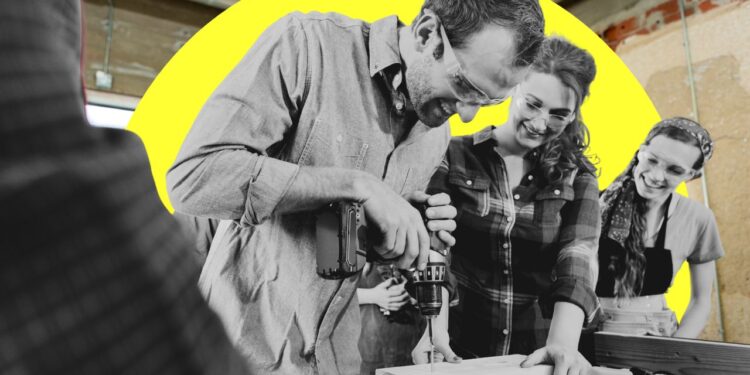- Makerspaces emerged as innovative areas where people can design, prototype, and create physical objects — combining elements of community workshops, studios, and classrooms.
- A significant investment is required to establish and maintain a makerspace, and safety protocols are critical given the use of potentially hazardous equipment. These factors must be weighed against potential benefits.
- While a makerspace can offer opportunities for innovation, collaboration, and practical hands-on work, there are also potential downsides like noise, space requirements, and the equitable use of resources that must be considered.
In the coworking world, a disruptive yet potentially transformative question looms: what if these collaborative hubs could extend their offerings beyond current services, and enter into the realm of physical creation and materialization of ideas? From enabling the creation of 3D-printed prototypes to laser-cut designs and more, the integration of a makerspace within the confines of a coworking space could infuse a new, exciting aspect to shared work environments.
What is a makerspace?
Makerspaces emerged as innovative areas where people can design, prototype, and create physical objects — combining elements of community workshops, studios, and classrooms.
These spaces are typically equipped with tools such as 3D printers, laser cutters, conventional woodworking equipment, and sewing machines, providing users with the resources to bring their ideas to life.
The purpose is largely to avoid having to spend a significant amount of money to purchase a tool that you only intend to use once, or if you simply don’t have the space at home to store such equipment.
Should coworking spaces include makerspaces?
The decision of whether or not to include a makerspace in a coworking environment needs to weigh the coworking space’s mission, the nature of its member base, resource allocation, safety, and the potential benefits and drawbacks.
Making a smart decision requires an understanding of how well this feature aligns with the interests and professional activities of members.
Coworking spaces tend to have diverse user communities, each with unique needs and interests. These can range from traditional professionals to entrepreneurs and freelancers, to artists and hobbyists.
Making a smart decision requires an understanding of how well this feature aligns with the interests and professional activities of members.
If members are predominantly engaged in sectors where physical prototyping and hands-on creativity are relevant, such as product design, architecture, or hardware technology startups, then a makerspace could directly contribute to the core work processes of this community.
Creating a makerspace requires a lot of thought, and money
Resource allocation is perhaps the most key factor. Establishing and maintaining a makerspace requires significant investment in equipment, materials, and space. Each equipment type requires a certain amount of floor space, not only for the machinery itself but also to allow for safe and comfortable operations.
Ongoing expenses might include maintenance, repair, material stocks, and potentially dedicated staff to manage the area and provide safety training and equipment orientation.
For coworking spaces considering a makerspace, safety needs to be priority
Safety considerations are critical in upholding and maintaining a makerspace. High-powered tools and equipment like saws, 3D printers, and soldering irons introduce risks of injury and require proper safety protocols.
Implementing these tools within a coworking space means that the establishment must ensure appropriate safety measures are in place, including but not limited to adequate ventilation, soundproofing, safety gear, and emergency procedures. It also means that all members using the makerspace must receive proper training to mitigate these risks.
There are many benefits of a makerspace, but drawbacks to consider
The potential benefits of integrating a makerspace within a coworking environment include fostering innovation, collaboration, and shared learning.
Collaboration and knowledge sharing are intrinsic to coworking spaces, and adding a makerspace can enhance this culture by allowing members to work together on physical projects.
Makerspaces can create an ecosystem that supports the development of tangible products, something that is usually not possible in a conventional office setting.
This appeals to a segment of professionals and hobbyists who require hands-on development as part of their creative or entrepreneurial process.
Collaboration and knowledge sharing are intrinsic to coworking spaces, and adding a makerspace can enhance this culture by allowing members to work together on physical projects.
There are also potential drawbacks to consider and recognize. Makerspaces can be noisy and disruptive, which may be incompatible with the working preferences of members who require quiet for concentration or client communication.
The physical space required for a makerspace might also diminish the space available for other amenities or more traditional work settings.
Additionally, not all members of the coworking space will use or benefit from the makerspace, which could raise concerns about the equitable allocation of membership fees toward shared resources.
Whether a coworking space should include a makerspace depends on a careful analysis of the members’ needs, the space’s mission and capacity, and a cost-benefit assessment that includes considerations for safety, utility, and community enhancement.
The success of such a venture hinges on a clear understanding of the value it can deliver to the coworking space’s community and an alignment with the broader goals of the coworking space itself. If a makerspace can be justified on these grounds, it can become a vibrant hub of creativity and innovation — adding significant value to the coworking ecosystem.


 Dr. Gleb Tsipursky – The Office Whisperer
Dr. Gleb Tsipursky – The Office Whisperer Nirit Cohen – WorkFutures
Nirit Cohen – WorkFutures Angela Howard – Culture Expert
Angela Howard – Culture Expert Drew Jones – Design & Innovation
Drew Jones – Design & Innovation Jonathan Price – CRE & Flex Expert
Jonathan Price – CRE & Flex Expert












